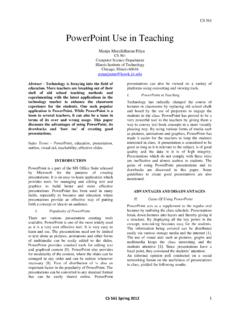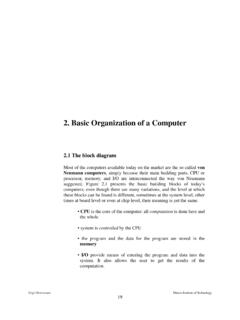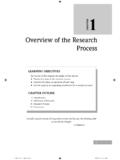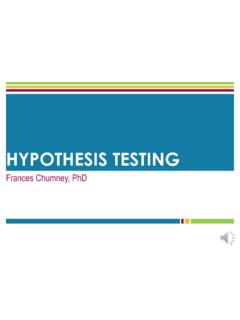Transcription of Software Testing Strategies Chapter 18
1 1 Software Testing StrategiesChapter 18 Click here to review SW Testing Techniques2 Review SW Testing TechniquesChapter 173 Software Testing Techniques Provide system guidance for designing tests that: Exercise the internal logic of a program White Box test cases design techniques Exercise the input and output Requirements of a program Black Box To Uncover ERRORS / BUGS / MISUNDERSTANDING OF REQUIREMNTS Testing Techniques Execute the program before the customer. To reduce the number of errors detected by customers. In order to find the highest possiblenumber pf errors Software Testing techniques must be used 5 Destructive PhaseConstructive PhasesSoftware Testing TechniquesAnalysisDesignImplementationTe stRequirement DocumentCodeTest Cases6 What is Testing and why do we do it?
2 Testing is the filter to catch defects before they are discovered by the customer Every time the program is run by a customer, it generates a test-case . We want our test cases to find the defects first. Software development is a human activity with huge potential for errors Testing before release helps assure quality and saves money7 Test Cases Design Test cases should be designed to have the highest likelihood of finding problems Can test by either: Black-box-using the specifications of what the Software should do Tests are derived from the I/O specification. Used in most functional tests. Other names: data-driven, input/output-driven. White-Box- Testing internal paths and working of the Software Examine internal program structure and derive tests from an examination of the program s logic.
3 Used to develop test cases for unit and integration Testing Other names: Glass-box, Logic-driven, Testing Uses the control structure of the program/design to derive test cases We can derive test cases that: Guarantee that all independent paths within a module have been visited at least once. Exercise all logical decisions on their TRUE or FALSE sides Execute all loops at their boundaries9A few White-Box Strategies Statement Requires each statement of the program to be executed at least once. Branch Requires each branch to be traversed at least once. Multi-condition Requires each condition in a branch be White-Box Strategies Basis Path Execute all control flow paths through the code.
4 Based on Graph Theory. Thomas McCabe s Cyclomatic Complexity: V(g) : #edges -#nodes + 2 Cyclomatic complexity is a SW metric that measures the complexity of a program. The larger V(g) the more complex. Data Flow Selects test data based on the locations of definition and the use of Coverage The criterion is to require every statement in the program to be executed at least once Weakest of the white-box tests. Specified by the as the minimum level of Coverage This criterion requires enough test cases such that each decision has a TRUE and FALSE outcome at least once. Another name: Decision coverage More comprehensive than statement Coverage Example:voidexample(int a, int b, float *x){1if ((a>1) && (b==0))2x /= a;3if ((a==2) || (x > 1)4x++;} Test case(s) , b=0, x= , b=1, x=114 Branch Coverage Test Case1.)
5 A=2, b=0 & x=32. a=3, b=1 & x=1 Coverage1. ace2. abd What happens with data that takes: abe, or acda > 1&&b==0x /= a;abcdeYesa==2||x > 1 Nox++YesNo15 Basis Path Execute all independentflow paths through the code. Based on a flow graph. An independent flow path is one that introduces at least 1 new set of statements or conditions Must move along at least 1 new edge on flow graph Flow graphshows the logical control flow using following notation: SequenceIfwhileuntil16 Corresponding Flow Graphi=1; = = 0;sum = 0;value[i] <> < ++;value[i] >=min &&value[i] <=maxsum=sum+value[i];i++; >0aver = ;aver=-999noNoYesYesNo of Paths12346578910111213V(g) = E -N + 217-13 + 2 = 6R = 6R1R3R2R4R5R618 Black-Box Testing Focuses on functional requirements of the Software without regard to the internal structure.
6 Data-driven, input/output-driven or behavior Testing Used in most system level Testing Functional, Performance Recovery Security & stress Tests set up to exercise full functional requirements of system19 Black Box Testing Find Errors in .. Incorrect or missing functions (compare to white box) Interface errors Errors in External Data structures Behavior performance problems (Combinations of input make it behave poorly). Initialization and Termination errors (Sensitive to certain inputs ( , performance) Blackbox done much later in process than white box. 20A few Black-box Strategies Exhaustive input Testing A test strategy that uses every possible input condition as a test case.)
7 Ideal Not possible! Random Test cases are created from a pseudo random generator. Broad spectrum. Not focused. Hard to determine the result of the Strategies Equivalence Partitioning A black-box Testing method that divides the input domain of a program into classes of data which test cases can be derived. Boundary Value Analysis A test case design technique that complements equivalence partitioning, by selecting test cases at the edges of the Value Analysis Experience shows that test cases exploring boundary conditionshave a high payoff. , Most program errors occur in loop control. Different from equivalence partitioning: Rather than any element in class, BVA selects tests at edgeof the class.
8 In addition to input condition, test cases can be derived for output conditions. Similar to Equivalence partitioning. First identify Equivalence classes, then look at the Case Documentation Minimum information for a test case Identifier Input data Expected output data Recommended to add the condition being tested (hypothesis). Format of test case document changes depending on what is being tested. Always include design Test Case FormatIdConditionInput DataExpected25 Test Case Formats Testing worksheet Test Case Identifier (serial number) Condition (narrative or predicate) Input (Stimuli data or action) Expected Output (Results) Test Results Actual Output (Results) Status (Pass/Fail)
9 26 Use this Test Case format for your ProjectTest Name/NumberTest ObjectiveTest DescriptionTest ConditionsExpected ResultsActual Results27 ANSI/IEEE Test Case Outline Test-case-specification Identifier A unique identifier Test Items Identify and briefly describe the items and features to be exercised by this case Input Specifications Specify each input required to execute the test case. Output Specifications Specify all of the outputs and features required of the test Test Case Outline Environmental needs Hardware Software Other Special procedural requirements Describe any special constraints on the test procedures which execute this test case. Interfaces dependencies List the id s of test cases which must be executed prior to this test case29 Software Testing StrategiesChapter 1830 Software Testing Strategies A formal plan for your tests.
10 What to test ? What to test when new components are added to the system? When to start Testing with customer? Testing is a set of activities that can be planned in advance and conducted systematically. 31 Software Testing Strategies Testing begins in the small and progresses to the large . Start with a single component and move upward until you test the whole system. Early tests detects design and implementation errors, as move upward you start uncover errors in requirements .32 Software Testing Strategies Characteristics of Testing Strategies : Testing begins at the component level, for OO at the class or object level, and works outward toward the integration of the entire system.













